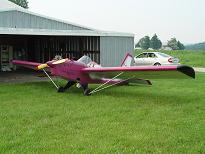
By (USUA #A86096)

|
| "Plum Krazee" (Large View) |
Hi again, Ultralighters.
This month's featured story comes to us from the Terre Haute Ultralight Club and starts with a bit of history as told to us by Bob Bedwell. Bob reminds us of the old World War II movies, that some of us still remember, showing P51 Mustangs with a red and yellow checkerboard painted on the nose. These aircraft were flown by the 357th Fighter Group stationed in Leiston, England. While one member of that group (Chuck Yeager) is very well known, there are many others who are remembered by history. The 357th, the first to receive the new Mustang, had more aces than any other group, and had the second highest kill record in the 8th Air Force.
Now what does this have to do with Ultralight flying do you ask? Well, a number of the remaining pilots from this famous group held a reunion recently in Linton, IN and were invited out to the Shawnee Airport. When they arrived at the airport they were met by the hastily formed and commissioned "Trike Squadron" composed of Allistair Wilson, Bob Bedwell, Niles Newton, Bob Turner, and Dave Johnson of the Terre Haute Ultralight Club. Despite the reported 20-25 mile an hour cross wind, eight of the 357th pilots, their wives, children, grandchildren and a few of the wives of some of the deceased pilots who were attending the reunion, climbed into the back seats of the trikes and were given an aerial tour of the Indiana countryside. In return for this fun morning of flying, the "Squadron" was invited to have dinner with the pilots of the 357th that evening where I'm sure many old and interesting stories flowed. During the evening, Allistair Wilson presented a slide show of his trike trip from the Gulf of Mexico to the Arctic Ocean (a trip we would all sure like to hear about if he could be enticed to write it up for one of the newsletters). When all was said and done, the reunioning members of the 357th and the members of the Terre Haute Ultralight Club had a day they will all long remember. Our thanks to the remaining pilots of the 357th for their service and their sacrifices, and our Kudos to the members of the Terre Haute Club for the hospitality they showed to these American heroes.
Trikes are in the news this month as we hear from the Albuquerque Sunrise Serenade that one of its members, Rich Hastings, destroyed his trike but escaped serious injury himself. He provides a copy of the accident report in the hopes that others may learn from it and not go through what he has just experienced. Reading from the accident report, it appears that Rich was trying out a new, non-factory wing on his AirBorne Redback trike when he attempted his first touch and go. The aircraft touched down at approximately 40 knots and the nose wheel began to shimmy. This shimmy increased rapidly in frequency and amplitude and Rich decided to lift off again. With the increase in power, however, without enough speed to immediately lift off, the shimmying nose wheel began to oscillate violently from side to side as the trike gained ground speed. The left main brace cable failed, and the left main gear folded under the trike and it flipped over. Rich was saved from serious injury by his seat belt and helmet. The cause of the accident was listed as: "This vehicle was not equipped with an optional hydraulic steering dampener offered by AirBorne Windsports on their trikes. Had it been equipped, the dampener would likely have dampened the nose wheel side to side oscillations, avoiding the accident." Contributing factors were listed as: "The Cosmos wing had a slightly higher stall speed than the AirBorne Wizard wing the pilot was familiar with. The accident landing was made with a slight crab angle at touchdown due to a light crosswind of 3-5 mph at the time of the accident. The pilot could have possibly prevented the accident by applying the brakes at the onset of the nose wheel oscillation rather than increasing power to go around." I guess you could also say that it is too late to initiate a go around once you are on the ground, or, problems appearing on the ground can't be solved by taking to the air. Or one could also comment that if the FAA would increase the allowable weight for ultralights, more safety equipment could be mounted on them. The hope is that you trike drivers can benefit from Rich's disclosure of the problems associated with his accident and increase your own safety margin.
The Middle Tennessee Ultralight Group shares with us some long accepted aviation truths such as:
That's it for this month. Fly safely but have fun!